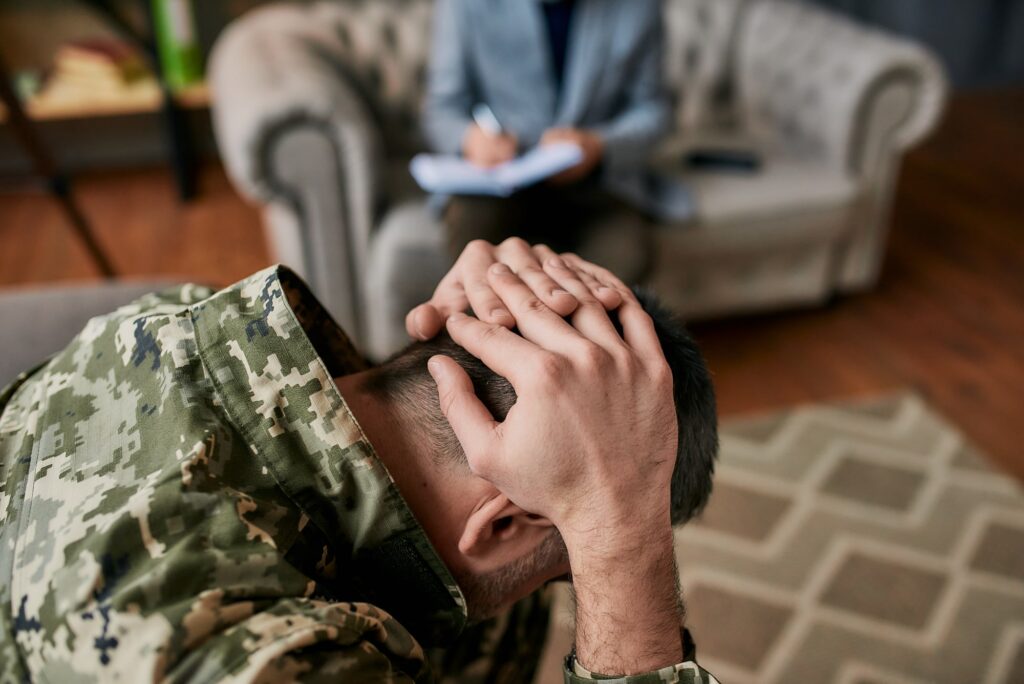At Transformations Treatment Centers, we understand the profound impact that trauma can have on an individual’s life. Post-Traumatic Stress Disorder (PTSD) is a condition that can develop after experiencing a traumatic event, causing intense, disturbing thoughts and feelings related to the experience that last long after the traumatic event has ended. Individuals such as veterans and first responders experience prolonged exposure to multiple traumatic events throughout their service.
Our trauma-informed treatment approach for PTSD in Delray Beach, FL, is designed to help individuals understand and manage their PTSD symptoms, heal from their trauma, and reclaim their lives. Reach out to us today at (800) 270-4315 to start the path toward improved mental health and recovery with trauma-focused psychological therapies to treat PTSD.

We offer a range of trauma-focused psychotherapy and PTSD treatment therapies designed to help individuals with a PTSD diagnosis, from veterans and first responders to sexual assault survivors and individuals who experienced childhood trauma. Our PTSD treatments and trauma-focused psychotherapies are evidence-based and tailored to meet the unique needs of each individual.
At Transformations Treatment Centers, we utilize EMDR therapy to help clients who have experienced traumatic events and PTSD symptoms. EMDR is a type of trauma-focused psychotherapy that reduces the effects of past trauma and upsetting memories by teaching clients better-coping methods. This PTSD treatment is particularly beneficial for individuals who have experienced sexual trauma or post-traumatic stress disorder. The therapy is connected with the biological mechanisms involved in Rapid Eye Movement (REM) sleep, causing internal associations as the clients process the memory and disturbing feelings from prolonged exposure to the trauma memory.
Neurotherapy, a type of biofeedback, is a general term for the integrated use of traditional EEG brain waves to create a map of the brain that can help a client identify and change behaviors and thoughts caused by mental illness. At Transformations, we use state-of-the-art technology to help coach the brain to optimal functioning, often called cognitive restructuring, as a PTSD treatment. This type of PTSD psychotherapy empowers clients to regulate their brain activity. It identifies the source of unwanted patterns or behaviors/thinking, such as learning how to manage traumatic memories from traumatic experiences. It’s a completely non-invasive and pain-free treatment of PTSD.
Our Evolv Wellness Program offers an experiential approach to trauma-focused treatments. It includes activities such as paddle boarding, kayaking, rock climbing, snorkeling, yoga, tai chi, sunrise meditation, and visiting sea turtle rehab centers. These activities provide a different approach to therapy and treatment by allowing clients to challenge themselves mentally and see how much they can overcome. We have found that engaging in these activities, combined with other PTSD treatments, can help reduce PTSD symptoms.
Recreational therapy is important to our successful drug and alcohol addiction treatment program. It provides multiple ways for individuals to learn new skills, engage in fun activities, and create new connections. This form of post-traumatic stress therapy is a vital first step to wellness, with activities that include music groups, outdoor activities, group therapy, sports, and art classes. These activities provide more of a creative outlet than some of the more physical forms of therapy, allowing you to learn how to process a traumatic event or memory in a healthy manner.

At Transformations Treatment Centers, we believe in a personalized and comprehensive approach to trauma-informed treatment for treating PTSD. We understand that PTSD affects everyone differently, and our team is committed to providing individualized care that addresses each client’s unique needs and experiences.
Our experienced therapists and clinicians work closely with each client to develop a personalized treatment plan. This effective treatment plan is tailored to address the individual’s specific symptoms, experiences, and goals. We use a combination of evidence-based therapies, holistic treatments, cognitive therapy, and supportive services to help our clients heal from trauma and build a strong foundation for recovery.
Depending on your needs, we provide a range of programs to help you overcome the mental distress caused by PTSD, including:
We recognize the unique challenges veterans and first responders face with PTSD. Our trauma-informed treatment approach is designed to address these specific needs, providing specialized care and many support groups for those who have served our community and country.
Veteran Rehab: Transformations Treatment Center offers a comprehensive rehab program for veterans struggling with addiction and PTSD. The program addresses the unique challenges faced by veterans, such as trauma from active duty and military sexual trauma (MST). The center provides various services, including detoxification, cognitive behavioral therapy, stress management, trauma treatment and resolution, and more. The program is designed to help veterans reintegrate into society and lead a healthy, productive life free from drug and alcohol abuse.
First Responder Rehab: This program is designed to support first responders, such as police officers, firefighters, corrections officers, and emergency personnel, dealing with stress, mental health issues, and substance abuse. The program offers a unique approach, providing treatments customized to their needs. Services include partial hospitalization programs, mental health treatments, and substance abuse programs. The goal is to help these brave individuals regain control of their lives and maintain the strength and courage they use to protect the community.

Taking the first step toward recovery can be the most challenging, but you don’t have to do it alone. At Transformations Treatment Centers, we’re here to guide you every step of the way. Our team of compassionate professionals is ready to help you navigate your journey to recovery.
Whether you’re seeking help for yourself or a loved one, we invite you to contact us and our team of experienced and compassionate mental health professionals. We’re here to answer your questions about trauma-focused psychotherapy, discuss our treatment options, and help you make an informed decision about your care.
Start your journey to recovery today with our trauma-focused interventions and trauma therapy for PTSD. Contact us at (800) 270-4315 to learn more about our services and how we can help you reclaim your life.